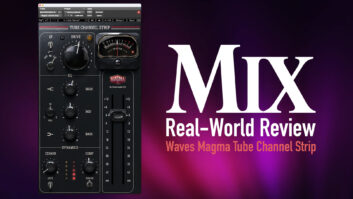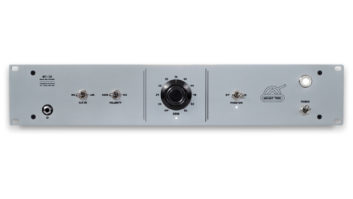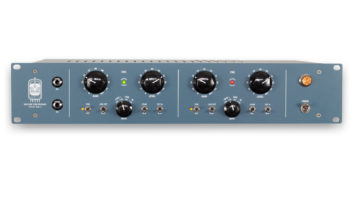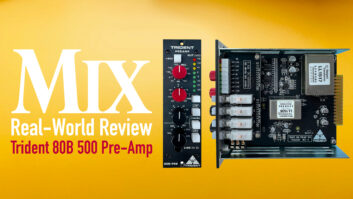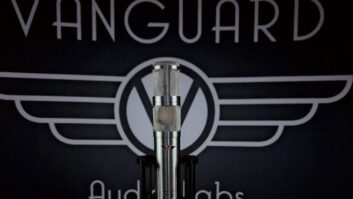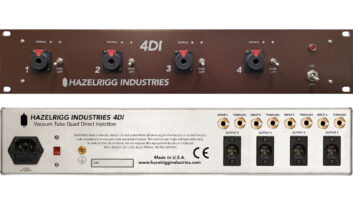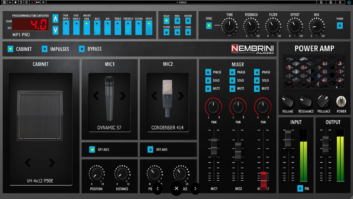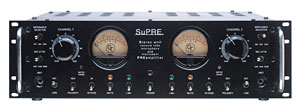
From the mind of “tube guru” Aspen Pittman comes the Groove Tubes SuPRE ($1,999), a 2-channel stereo tube mic preamp that puts a lot of features into a hefty, three-rackspace package. Taking its core DNA from the company’s ViPRE, the SuPRE features rear panel mic and line inputs for each channel, with an overriding (and handy!) instrument/line input on the front. A three-position attenuator (0/15/30 dB) allows for quick initial setups, along with two retro-looking, large, black Bakelite front panel knobs for continuously variable gain on each channel.
A total of 15 bat-style flip switches control a variety of necessary and standard functions. A timed power-on switch in the center of the front panel lets you clearly see the unit’s status: flashing for power up and a solid cool-blue for ready/on status. Each channel has 48VDC phantom power, polarity reverse and 75Hz highpass filter switches. Easy-to-read analog VU meters, which are independently adjustable for accurately lining up 0 VU, complete SuPRE’s “vintage” look and feel.
Similar to the ViPRE, the SuPRE offers variable (300/600/1,200-ohm) impedance switching. Four high-quality, nickel-core I/O transformers balance out the buffered package, with a hefty 72 dB of gain per channel. For this kind of gain, Groove Tubes uses a total of four of its own specially selected vacuum tubes. Each channel boasts a pair of dual-triode GT6922 and pentode/triode GT6GH8 tubes, all in shielded casings.
CLASSY CHASSIS
I always like to peek under the hood to see what makes the unit tick. Not surprisingly, the SuPRE is laid out well and is solidly built, with lots of attention to detail. Robust construction techniques include additional grounded metal shielding on the power supply connections to/from the front panel switch and rear panel fuse socket, along with cleanly grouped, tied wiring bundles.
With no ventilation fan, the unit runs warm to the touch but not overly hot, even after hours of continuous use. There’s enough space in the unit to let some of the warmer components play nicely together. On powering down, you can hear the internal relays clicking off in sequence — another nice touch to keep spikes down and nasty transients out of the audio path.
SUPRE FRIEND
Several things were appealing and helpful during my initial setup and use of the SuPRE. In my first session, there wasn’t a lot of time to fuss with settings beforehand. With talent waiting, it was time to “grab it and go.” The SuPRE sounded great even when the settings weren’t ideal (input too hot, peaking VUs, etc.). Although I wasn’t looking for it at the time, I immediately liked the warm, overdriven sound that I accidentally got on the first vocal track that I attempted with singer/songwriter Keith Rounds. Once the proper settings were dialed in, I was struck by the unit’s noise-free, no-compromise sound. With vocal on one track and acoustic guitar on the other, I had two ultraquiet, yet warm sources to start my session.
Male and female voice-over sessions showed SuPRE to be a lovely, warm and full-sounding preamp. Various large-diaphragm mics (Audio-Technica AT4050 and AT4040s, MXL M3, etc.) really sparkled with lots of full low end, full midrange and crisp top end, all without sounding hyped or overdone.
Although one wouldn’t normally take something like this out on a live remote session (more on that later), I had to hear what it would sound like handling instruments as diverse as solo bassoon and grand piano. On one of my classical dates with the Chamber Orchestra of Philadelphia, the SuPRE was — not surprisingly — quiet, detailed and solid. This was a first for me (and the SuPRE?): a chance to record an all-too rare bassoon performance by classical bassoonist Michelle Rosen, coupled with a vintage Neumann KMi-84.
Back in the studio, the SuPRE was used to warm up some rather unexciting and sterile drum and bass tracks from an old digital tape session; in this case, for remixing. With the best of both worlds — digital remixing and automation — dialing in SuPRE’s warm and overdriven tube character added just the right presence for some punchy, bouncy and round sounds from the rhythm section.
FINAL THOUGHTS
The SuPRE is one warm, fun and friendly preamp. Its retro looks, coupled with its uncompromising electronics, make this unit hard to resist. Setup and alignment were fast and user-friendly; careful tweaking during setup always helps, but right out of the box this is a very forgiving unit.
One very minor quibble: I wish there was more support for the two large channel cards. I’d feel safer seeing some kind of anchor or brace in the middle of these substantial circuit boards, which seem to beg for extra support near or under the tube socket areas. As such, I wouldn’t recommend the SuPRE for touring racks; for general studio use, it should be quite safe and more than adequate.
Over a wide range of sessions, I never got the impression that the SuPRE was ever straining or harsh; the sound seemed limitless, distorting only when asked to. For full-sounding and robust new tracks — or warming up colder, older digital material — take the SuPRE for a test drive. But be warned: You may not want to give it back.
Groove Tubes, 818/361-4500, www.groovetubes.com.
Joe Hannigan runs Weston Sound & Video in Greenville, Del.
